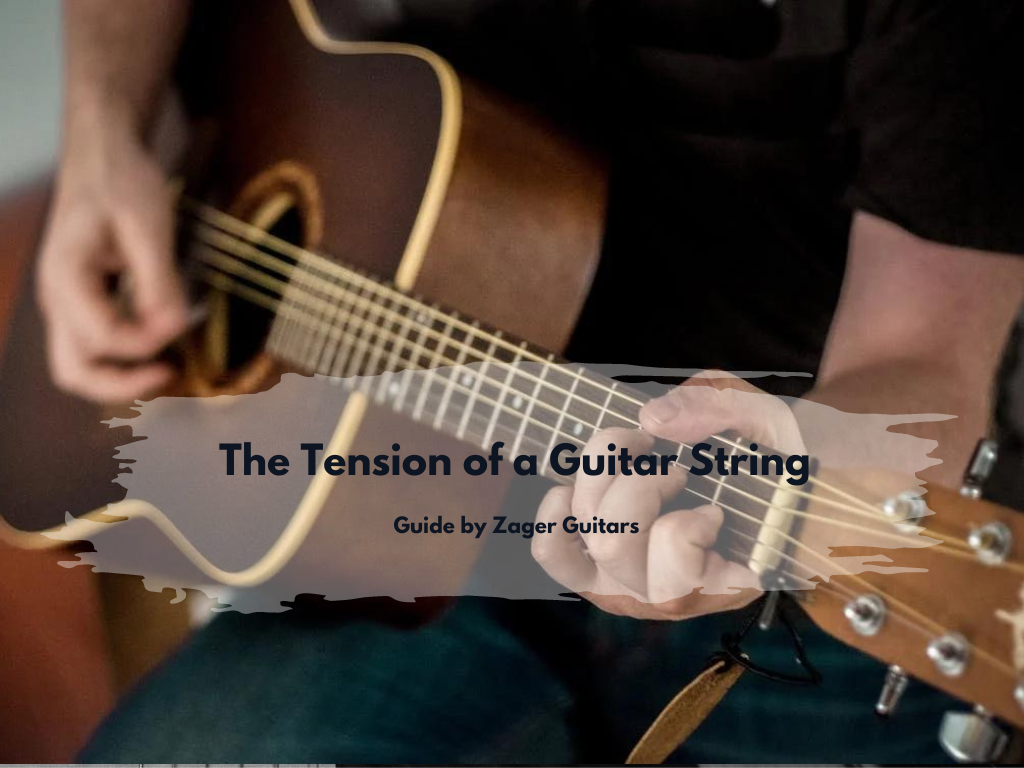The Tension of a Guitar String – A Guide By Zager


Meta Description:
Let’s dive into the fascinating world of guitar strings! Picture this: a guitar string is like a tightrope walker, under much higher tension strings, and ready to perform some musical acrobatics. When you pluck that string, it starts dancing, vibrating at different speeds. And guess what? The faster it vibrates, the higher the pitch it sings!
Now, here’s where things get groovy. The thickness of the string plays a significant role in its performance. Thicker lines and thicker strings are like cool cats, taking their time to vibrate and belting out those deep, low notes. On the other hand, thinner strings are all about speed, buzzing with high-pitched excitement like a hummingbird on a sugar rush.
But what creates all this tension in the first place? Well, it’s a combo of factors, my friend. The weight of the string itself, around 6.5 ounces on average, pulls on it, a balanced tension while the force you apply as a player adds that extra oomph. The result? A string that’s tight and ready to rock!
Now, let’s talk about tuning. Depending on the gauge and tuning, the tension on a string can vary like a rollercoaster ride. Heavy gauge strings bring the thunder with more pressure, while lighter ones give you a smoother, gentler experience. And when it comes to tuning, lower pitches mean less tension on the exact string, while higher pitches crank up the tension meter.
Hold tight because we’re about to explore the wonderful world of guitar necks. These necks are like superheroes, designed to resist bending like champions. Bend too much, and you’ll have a musical inconvenience and a full-blown disaster. That’s where the truss rod comes to the rescue! It’s a trusty metal rod anchored in the neck, keeping those strings in tension and maintaining stability. Think of it as the secret weapon for a happy guitar neck.
Do you know what’s awesome? You can fine-tune your guitar’s truss rod using a nut. No, not the kind you eat, but the type that adjusts the rod’s action. It’s like having a magical knob to control the neck’s behavior. And here’s a pro tip: as long as you have that trusty steel rod for support, even a lot of tension won’t bring your neck down. Keep it strong, just like a guitar hero!
Be careful! Things can get wonky if you don’t correctly adjust the tension and neck relief. The wood below the guitar’s bridge might rise, causing musical mischief. We want our guitars to stay in tune and look good doing it!
Speaking of balanced tension strings, did you know each has its breaking point? When a line is linked to the bridge and the nut, it can only handle so much. If it reaches 40% of its tension, snap! The show is over for that string. So let’s ensure we keep them happy and avoid stringy meltdowns.
If you’re curious about the numbers, let me share some fun facts. The pressure from the strings pulling on the neck of a standard-tuning acoustic guitar can reach a whopping 160.54 pounds! That’s some serious musical muscle right there. And when we peek at Figure 5, we can see that the average tension for each string of classical guitar wiggles between 60 and 80 Newtons. It’s like they’re having their little dance party!
So, my friend, next time you strum your fingers on those guitar strings, remember the tension they carry, the pitches they create, and the dance they do to bring music to life. It’s a wild ride filled with energy, excitement, and
How To Get The Best Sound From Your Guitar?

To achieve a sweet sound from your guitar, you’ve got to put in some elbow grease. It’s all about finding that sweet spot of pressure. You don’t want to be too light-handed, producing weak and muffled notes. On the flip side, excessive stress can make your guitar sound like it’s having a buzzing party, and that’s not what we’re aiming for.
So, let’s find that Goldilocks zone of pressure-balanced tension guitar strings, where everything feels just right. Begin gently, allowing the lines to respond with clarity and precision. As you get more comfortable and in tune with your instrument, gradually increase the pressure, adding just enough oomph to create those glorious sounds.
Remember, it’s a delicate balance. You want to apply sufficient pressure to produce a robust and resonant tone while avoiding the pitfalls of over-strumming or fretting too hard. So, take time, find your groove, and let the magic happen. Your guitar will thank you with harmonious melodies and a smile that reaches from ear to ear.
How Hard Should You Press On Guitar Strings?

The amount of pressure you exert on the guitar strings is a personal choice and depends on your playing technique. Some guitarists prefer a light touch, while others apply more pressure.
Ultimately, it’s all about finding what works best for you and achieves the same pitch and desired sound.
You must apply enough pressure for the strings to contact the fret to produce a clear tone. However, it’s essential to avoid excessive force, as it can lead to unnecessary strain on your hands and wear on the guitar. Beginners often tend to press too hard, slowing down their playing speed. This can result in inconsistent or unpleasant sounds and even damage the fretboard.
A helpful exercise is to fret a note at the fifth fret using your first finger on your fretting hand. You’re not applying enough pressure if the sting sounds muted or muffled. Repeat the process, gradually increasing the pressure until you achieve a precise and resonant tone.
Finding the right amount of force may take some practice, but it’s crucial for maintaining a consistent manner of play and minimizing unnecessary strain.
If you’re having trouble finding the optimal pressure, note any unintentional bending or unwanted string noise while playing. By being mindful of these issues, you can adjust and work towards a smoother and more controlled playing technique.
Remember, it’s all about balancing enough pressure to produce a good tone and avoiding excessive force that can hinder your playing.
So, keep experimenting, listening, and adapting until you discover your sweet spot of pressure for your guitar.
How Much Tension Can A Guitar Neck Take?

Regarding the tension on a guitar neck, it’s essential to know that it can handle more than what might be initially comfortable for you, such as the pressure exerted by standard E strings at 25.5 inches.
The tension on a guitar neck depends on the thickness of the strings. It’s around 200 pounds on average, roughly translating to 20-80 kilograms of lateral force. Thicker lines create higher tension on the neck compared to lighter ones. While higher pressure won’t necessarily harm your instrument, it can shorten its overall lifespan.
Applying excessive strain on the guitar neck may lead to warping, especially if the channel is made of delicate wood. Additionally, other parts of the guitar body could potentially suffer damage. In such cases, it’s recommended to seek the assistance of a technician rather than attempting to fix it yourself.
If you’re experiencing discomfort or inconsistency while playing on different areas of the scale length of the fretboard, it’s worth checking the relief of your neck. A slightly arched neck with some comfort can be enjoyable, while excessive bowing can be frustrating. The combination of the bridge and truss rod can sometimes make it challenging to achieve proper tuning across different notes.
Remember, taking care of the tension and relief of your guitar neck is crucial to ensure optimal playability and preserve the longevity of your instrument. If you have any concerns or encounter persistent issues, seeking professional guidance is always intelligent.
How Much Force Is On A Guitar Neck?
When your guitar strings are correctly tuned, they exert tension on the neck that can reach up to 200 pounds. However, it’s important to note that removing all the strings from your guitar, when done correctly, will not cause any harm to the instrument.
You should loosen the lines by turning the pegs to remove them. This step-by-step approach ensures a safe and proper removal process for strings tuned well.
High Tension Guitar Strings: The Perfect Sound, With A Risk Of Injury
Guitarists often prefer high-tension strings, which are well-suited for fast and aggressive soloing, including shredding leads. However, it’s essential to be aware that, like any situation in life, it is possible lower tension strings to go overboard and cause damage. You may risk serious harm if you push the string tension to its limits without taking proper precautions.
For instance, imagine you’re shredding a lead solo on a guitar with high-tension nylon strings. If a string snaps, it can cut your finger or, in unlucky scenarios, even cause injury to your eye.
Therefore, it is crucial to exercise caution when dealing with high-tension strings. If you’re unsure about the amount of tension you’re applying, it’s advisable to tune the line to the correct pressure using the pegs. This approach ensures you achieve the optimal balance of sound quality and safety.
Remember, it’s always better to prioritize safety and take the necessary precautions when handling high-tension strings. Doing so lets you enjoy the best possible sound while minimizing the risk of accidents or injury.
FAQs
What Tension Do Guitar Strings Break at?
If the instrument is tuned, you apply tension to the strings until it reaches its desired tone. The string is built to hit a specified note length with varying pressure without breaking. Each string supports approximately 40% of the tension.
How Much Force Do Guitar Strings Exert?
Well, honestly a lot. The tension in guitars is mainly affected by string length and thickness, and the pressure on the strings varies in magnitude. Heavier strings cause more tension in the necks of guitars. Continue reading for information about the theory of tensions in guitar necks.
How Many Pounds of Force Do Guitar Strings Have?
A typical electrical guitar string weighs around 90 lbs per string. Guitar string tension is determined based on string tension and tuning. A standard guitar string gauge will probably have between 60 pounds of pressure.
How Tight Should Guitar Strings Feel?
In the electric guitar, the same tension of the strings should be tight enough to make the notes clear but not so tight that the series is impossible to hold up. The pressure of strings is usually looser on acoustics than on electric guitars because too much stress may ruin the fragile sonic board.
